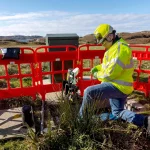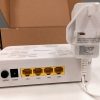Openreach Expand Large Scale Trial of SRA on FTTC Broadband Lines
Openreach (BT) has today announced that they will conduct a “large scale” UK trial of Seamless Rate Adaption (SRA) technology on Fibre-to-the-Cabinet (FTTC / VDSL2) based superfast broadband ISP lines (40-80Mbps), which could improve service stability by varying the speed more effectively.
The technical way of explaining SRA is to say that it can be used to “reconfigure the total data rate by modifying the framing parameters and the bits and fine gains parameters.” If the noise condition (interference) improves then SRA can be used to gradually increase the data rate again, potentially taking it all the way back up to what you had before a nasty bit of sudden noise impacted the line.
SRA is technically nothing new to Openreach’s hybrid fibre network and it’s a standard part of the latest G.fast standard. Prior to that the operator has also previously tested it alongside the problematic VDSL2 Vectoring technology (2014 to 2015) and they recently tried to incorporate it as part of their Long Reach VDSL tests (here), which were shelved.
Advertisement
Earlier this year the operator decided that it might be better to try implementing SRA on its own and so they setup a small Proof of Concept (PoC) trial with 200 lines via Huawei based street cabinets (here). The service was applied gradually (line-by-line) and Dynamic Line Management (DLM) was also disabled. This ran for several months and after that Openreach began reviewing its impact, which brings us back to today.
This briefing is to inform all CPs that following the successful proof of concept earlier this year we will be trialling Seamless Rate Adaption (SRA) on a larger volume of lines
We’ve published a briefing for CPs relating to SRA, which will vary the speed of a line as noise margin changes reducing the propensity to retrain, whereas today on NGA1, if the noise margin drops beyond a certain threshold, the line will retrain. Openreach will be running a large-scale trial to prove the benefits of this change.
Sadly the briefing doesn’t say anything more than that, but we understand from our sources that the larger trial is likely to target around 100,000 lines (at least that was the original plan) and will probably run until around the start of Spring 2019.
As usual a big question mark sits over whether or not the larger trial will include any ECI cabinets, which have a history of being quite problematic (unlike Huawei’s otherwise dependable kit).
Mark is a professional technology writer, IT consultant and computer engineer from Dorset (England), he also founded ISPreview in 1999 and enjoys analysing the latest telecoms and broadband developments. Find me on X (Twitter), Mastodon, Facebook, BlueSky, Threads.net and Linkedin.
« JT Picks ZTE to Deploy 5G Mobile on the British Channel Islands
5G Mobile Trial in Japan Delivers Broadband Speeds of 27Gbps »

















































Comments are closed